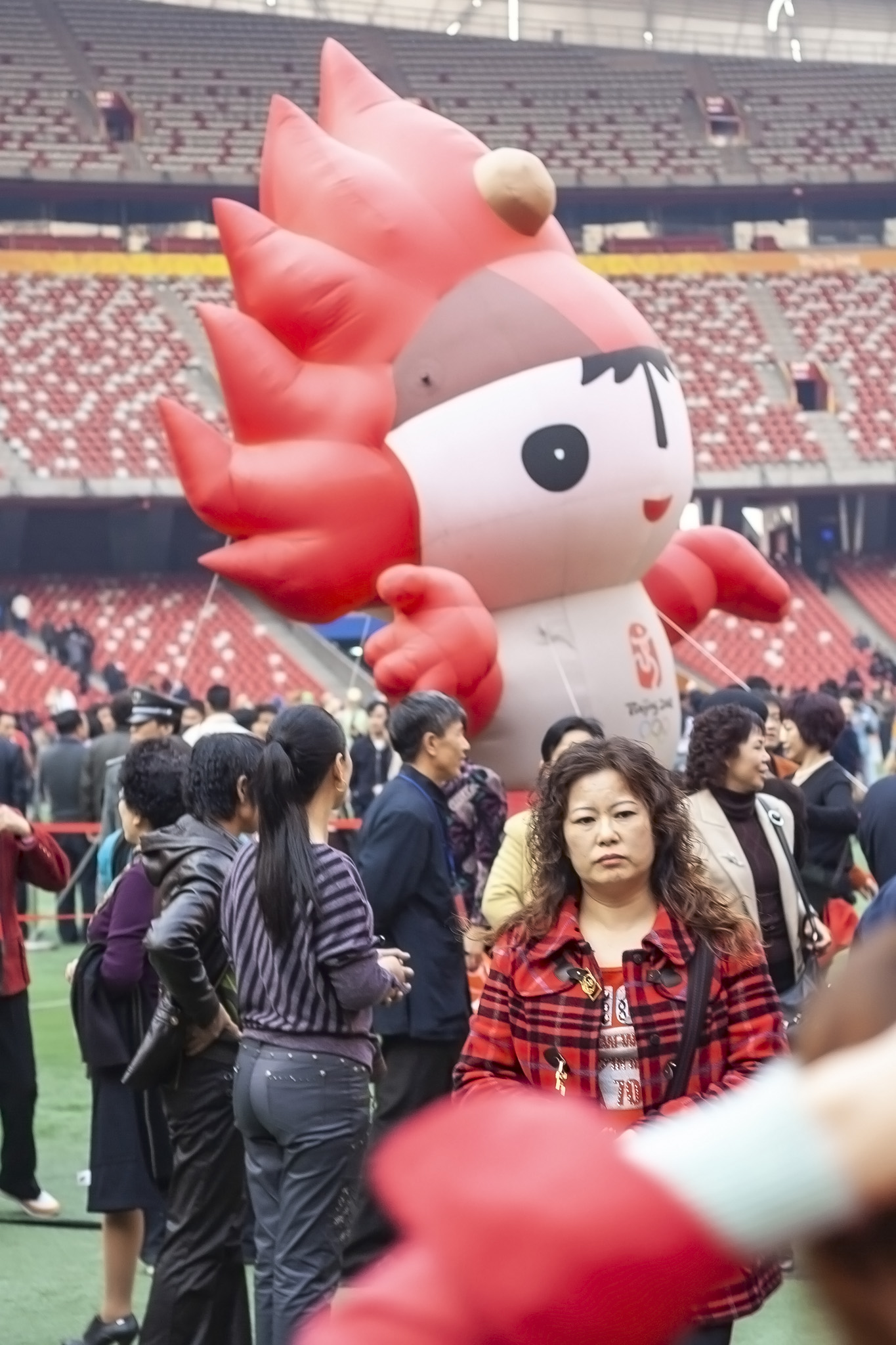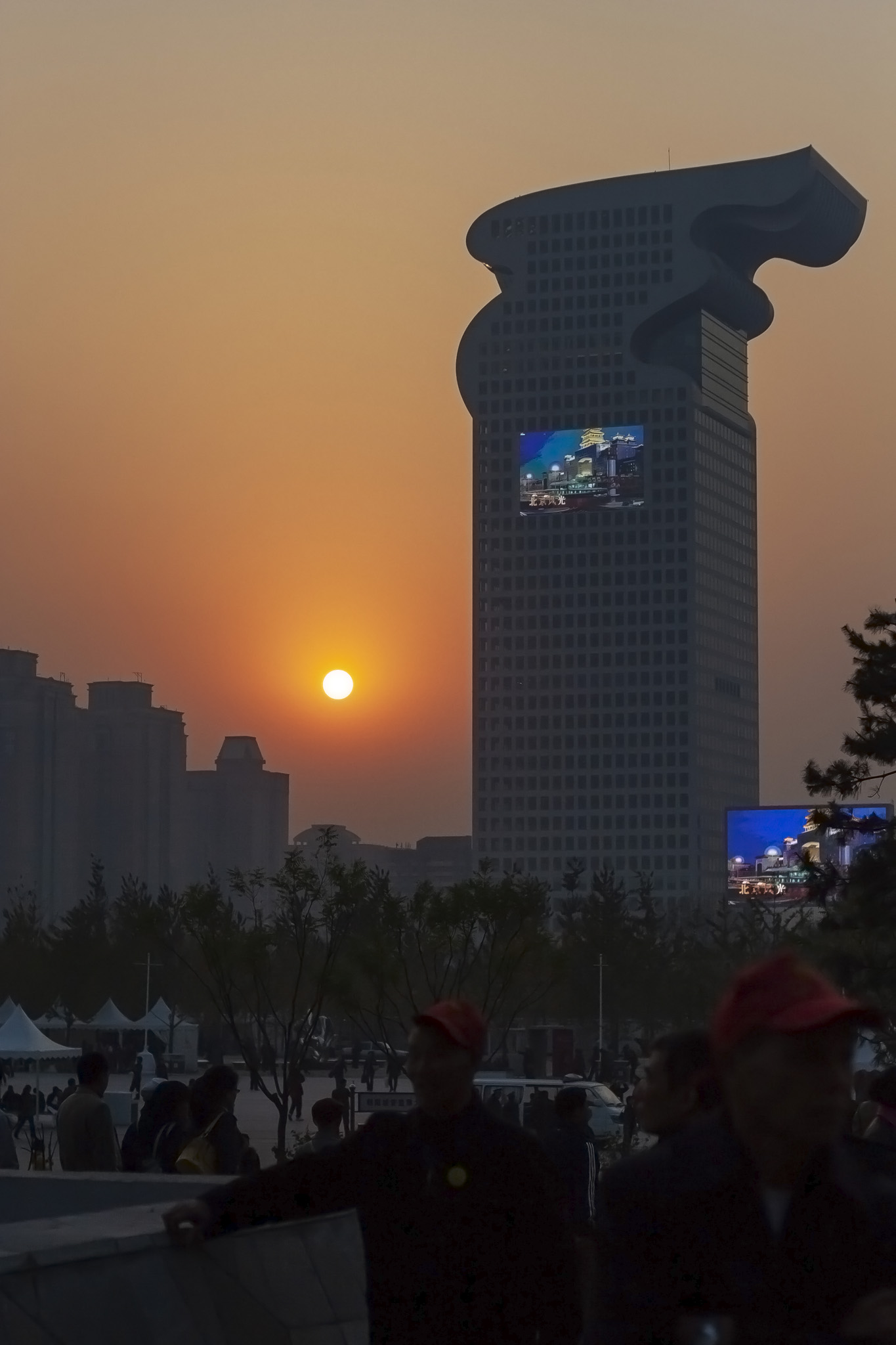From the National Aquatics Centre we walked the roughly one hundred metres to the Beijing National Stadium which, like the building we’d only just explored, had its own nickname: the Bird’s Nest. It’s not hard to guess why. However, the stadium wasn’t designed to look like a bird’s nest; it was designed to have an external, light, natural-in-appearance, random-looking shell, but one that could hide the support structures required for a retractable roof, and only picked up the nickname from its Swiss architects afterwards. For the Chinese, though, this was fine because in their culture a bird’s nest soup is something for a special occasion.
Before we went inside we heard some of the design decisions from our tour guide, including that the planned retractable roof was removed from the design late in the process following safety concerns and that the interior had been subtly altered as a result to protect the crowd from the elements a little better.
Our position outside the national stadium entrance allowed us to look back beyond the aquatics centre and to the western sky where the sun was dipping in the late afternoon of this November day. This gave my wife and I the chance to hunt for a spot to take some photos with the Pangu Plaza “dragon building” (but it still looks like a rabbit to us) in the foreground.
One other thing we really enjoyed outside the Bird’s Nest stadium was the other tour groups and visitors to the Beijing landmark. Our guide had already told us earlier in the day that we might be a bit of a novelty to other Chinese people. Beijing was a modern city but a lot of the visitors who we would see at the tourist locations would be from other parts of China, coming in to see the site of the 2008 Olympics of only a few months prior, or seeing the Great Wall or the Forbidden City where we’d also be visiting over the coming days. We would in many cases be the first westerners they would ever have seen in the flesh and we shouldn’t worry about being stared at.
We weren’t just stared at. It was amusing to look at some of the other groups and see the local guide surrounded by two dozen Chinese people (all wearing the same cap to identify their group in a lot of cases), most of them paying no attention to what was being said and simply looking at us or, in some instances, sidling over to get close and see if they could hear some English being spoken. We also saw some people shuffle close in order to surreptitiously pose for photos for friends or family in front of our strangeness.
Our guide led us into the Bird’s Nest stadium and gave us some free time to have a look around. Access was pretty much unlimited although we weren’t too keen to get too far from our guide and the exit, with an eye on when we’d need to meet up outside again. TV screens showed promotional video from the Olympics and there was a loud buzz of conversation filling the interior space.
The central area of the stadium contained some mannequins dressed in clothing worn at either the opening or closing ceremonies of the recent summer games. Understated colours and subtle patterns were not the fashion of the time.
The mascots of the 2008 Olympics were also represented, albeit only two of them and in inflatable form. The five Fuwa (good luck dolls) each represented a ring of the Olympics logo and therefore a continental area taking part in the games.
- Beibei – Blue – Europe – Water
- Jingjing – Black – Africa – Wood
- Huanhuan – Red – America – Fire
- Yingying – Orange – Asia – Earth
- Nini – Green – Oceania – Metal
As you can see, both Huanhuan (America) and Nini (Oceania) were in attendance when we visited the Beijing National Stadium.
Outside the stadium once more I couldn’t resist a couple more shots of the setting sun and the deep colours caused by a little of that famous Beijing pollution (although it wasn’t that bad and never affected us during our visit).
It will be good to see the stadium and general area in use once more during the 2022 winter games just to see what’s changed. We had a lovely little visit and when you consider that most trips we do are of a far more ancient historical nature, it was good to have this first day of excursions arranged through Princess Cruises at the start of our honeymoon holiday in Asia be something very different.
Our guide led us the few minutes’ walk back to the bus where we’d be whisked (well, as whisked as Beijing evening traffic allowed) back to the Great Wall Sheraton Hotel, our home for these first few days in China.




























